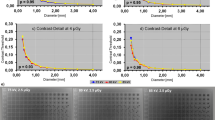Abstract
We aimed to optimize the exposure conditions in the acquisition of soft-tissue images using dual-energy subtraction chest radiography with a direct-conversion flat-panel detector system. Two separate chest images were acquired at high- and low-energy exposures with standard or thick chest phantoms. The high-energy exposure was fixed at 120 kVp with the use of an auto-exposure control technique. For the low-energy exposure, the tube voltages and entrance surface doses ranged 40–80 kVp and 20–100 % of the dose required for high-energy exposure, respectively. Further, a repetitive processing algorithm was used for reduction of the image noise generated by the subtraction process. Seven radiology technicians ranked soft-tissue images, and these results were analyzed using the normalized-rank method. Images acquired at 60 kVp were of acceptable quality regardless of the entrance surface dose and phantom size. Using a repetitive processing algorithm, the minimum acceptable doses were reduced from 75 to 40 % for the standard phantom and to 50 % for the thick phantom. We determined that the optimum low-energy exposure was 60 kVp at 50 % of the dose required for the high-energy exposure. This allowed the simultaneous acquisition of standard radiographs and soft-tissue images at 1.5 times the dose required for a standard radiograph, which is significantly lower than the values reported previously.








Similar content being viewed by others
References
MacAdams HP, Samei E, Dobbins J, Tourassi GD, Ravin CE. Recent advances in chest radiography. Radiology. 2006;241:663–83.
Macmahon H, Li F, Engelmann R, Roberts R, Armato S. Dual energy subtraction and temporal subtraction chest radiography. J Thorac Imaging. 2008;23:77–85.
Kelcz F, Zink FE, Peppler WW, Kruger DG, Ergun DL, Mistretta CA. Conventional chest radiography vs. dual-energy computed radiography in the detection and characterization of lung nodules. Am J Roentgenol. 1994;162:271–8.
Uemura M, Miyagawa M, Yasuhara Y, Murakami T, Ikura H, Sakamoto K, Tagashira H, Arakawa K, Mochizuki T. Clinical evaluation of pulumonary nodules with dual-exposure dual-energy subtraction chest radiography. Radiat Med. 2005;23:391–7.
Tagashira H, Arakawa K, Yoshimoto M, Mochizuki T, Murase K. Detectability of lung nodules using flat panel detector with dual energy subtraction by two shot method: evaluation by ROC method. Eur J Radiology. 2007;64:279–84.
Kashani H, Gang JG, Shkumat NA, Varon CA, Yorkston J, Metter RV, Paul NS, Siewerdsen JH. Development of a high-performance dual-energy chest imaging system: initial investigation of diagnostic performance. Acad Radiol. 2009;16:464–76.
Kashani H, Varon CA, Paul NS, Gang GJ, Metter RV, Yorkston J, Siewerdsen JH. Diagnostic performance of a prototype dual-energy chest imaging system: rOC analysis. Acad Radiol. 2010;17:298–308.
Oda S, Awai K, Funama Y, Utsunomiya D, Yanaga Y, Kawanaka K, Nakaura T, Hirai T, Murakami R, Nomori H, Yamashita Y. Detection of small pulmonary nodules on chest radiographs: efficiency of dual-energy subtraction technique using flat-panel detector chest radiography. Clin Radiol. 2010;65:609–15.
Veldkamp WJ, Kroft LJ, Geleijins J. Dose and perceived image quality in chest radiography. Eur J Radiology. 2009;72:209–17.
Fischbach F, Freund T, Rottgen R, Engert U, Felix R, Ricke J. Dual-energy chest radiography with a flat-panel digital detector: revealing calcified chest abnormalities. AJR Am J Roentgenol. 2003;181:1519–24.
Samei E, Flynn MJ. An experimental comparison of detector performance for direct and indirect digital radiography systems. Med Phys. 2003;30:608–22.
Borasi G, Nitrosi A, Ferrari P, Tassoni D. Onsite evaluation of three flat panel detectors fordigital radiography. Med Phys. 2003;30:1719–31.
Saunders RS Jr, Samei E, Hoeschen C. Impact of resolution and noise characteristics digital dariographic detectors on the detectability of lung nodules. Med Phys. 2004;31:1603–13.
Ricke J, Fischbach F, Freund T, Teichgraber U, Hanninen EL, Rattgen R, Engert U, Eichstadt H, Felix R. Clinical results of CsI-detector-based dual-exposure dual energy in chest radiography. Eur Radiol. 2003;13:2577–82.
Ruhl R, Wozniak MM, Werk M, Laurent F, Mager G, Montaudon M, Pattermann A, Scherrer A, Tasu JP, Pech M, Ricke J. CsI-detector-based dual-exposure dual energy in chest radiography for lung nodule detection: results of an international multicenter trial. Eur Radiol. 2008;18:1831–9.
Fujifilm. Image processing (Energy subtraction). General description of image processing. Tokyo: Fujifilm; 2002. p. 209–17.
Shkumat NA, Siewerdsen JH, Dhanantwari AC, Williams DB, Richard S, Paul NS, Yorkston J, Van Metter R. Optimization of image acquisition techniques for dual-energy imaging of the chest. Med Phys. 2007;34:3904–15.
Kato H, Fujii S, Yoshimi Y. Development of computer code, SDEC, for evaluation of patient surface dose from diagnostic X-ray. Nihon Hoshasen Gijutsu Gakkai Zasshi. 2009;65:1400–6.
Guilford JP. The method of rank order. Psychometric methods. New York: McGraw-Hill Book; 1954. p. 251–306.
Neitzel U. Status and prospects of digital detector technology for CR and DR. Radiat Prot Dosimetry. 2005;114:32–8.
Acknowledgments
Financial support for this study was provided by Fujifilm Corporation.
Author information
Authors and Affiliations
Corresponding author
About this article
Cite this article
Fukao, M., Kawamoto, K., Matsuzawa, H. et al. Optimization of dual-energy subtraction chest radiography by use of a direct-conversion flat-panel detector system. Radiol Phys Technol 8, 46–52 (2015). https://doi.org/10.1007/s12194-014-0285-y
Received:
Revised:
Accepted:
Published:
Issue Date:
DOI: https://doi.org/10.1007/s12194-014-0285-y




